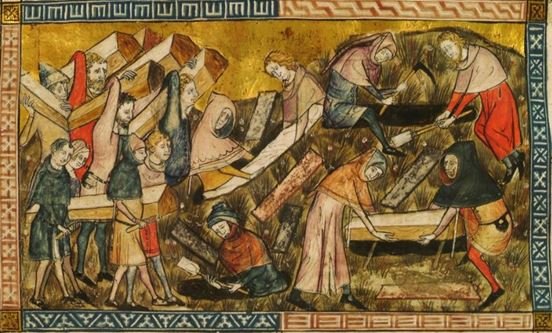The Black Death: Plague, Symptoms, Death Toll, & Other Major Facts

The Black Death: Questions and Answers
The Black Death was a terrible bubonic plague that decimated 14th century Europe, as well as other parts of Asia, causing a great chunk of the population to shrink within a space of about four years. The following are some very detailed answers to all the major questions about the Black Death:
What was the Black Death?
The Black Death was a medieval epidemic, commonly called the ‘pestilencia’, that tore through Europe during the mid-1300s, leaving nothing but death and misery behind. It was an infectious disease that affected both animals (rodents in particular) and humans all across Asia and Europe. Particularly, it spawned a dark cloud all over Europe, causing the times to be very dire. Europeans even resorted to stacking dead bodies up in the thousands across towns and cities.
The devastation caused by the Black Death is unrivaled by any other plague in recorded human history. No one at that time had a clue as to what exactly was causing the plague. In some cases, dead bodies were left abandoned on the streets as no one dared attend to them or even perform the necessary funeral rites. The stench from homes, where people had succumbed to the disease, was palpable.
In what year did the Black Death start?
Many medieval historians place the beginning of the Black Death in 1347. In less than 6 months this nature’s scourge had reached the shores of Spain. By the summer of 1848, the disease had made its way across the English Channel. The epidemic finally ran out of steam around the 1350s.
Which part of Europe had the first case of the Black Death?
The true source of the Black Death is believed to have come from the near East. It has also been researched that sailors from places in the Black Sea brought it along with them to the port cities of the Mediterranean. The disease path somehow followed the same path of trading routes across Europe. Therefore, from Italy and the Mediterranean, the Black Death moved westward into Spain. Then, there was France and England. The disease didn’t halt there; it reached the far edges of the Nordic countries and Russia.
What was the mode of transmission?
Animals, especially rodents, were the major carriers of the disease. The disease was housed in the fleas of rats. People acquired it when these infected fleas took a bite at them. The disease, a mixture of bubonic, septicemic and pneumonic plague, mainly spread through human-to-human contact.
The Black Death spread through infected tissues and fluids on the body of an infected human or animal. It has also been stated that breathing the air droplets of people or animals infected with plague could lead to transmission. Once the medieval people caught on to its mode of transmission, they took to burning the clothes of the deceased. They also avoided venturing into crowded places in the cities.
Which section of the population suffered the most?
The disease was social class and age blind. All across the social pyramid of Europe, the disease reared its ugly neck. Regardless of one’s position or economic status, the plague found its way, one way or the other. At some point in time, and in some places, there were not even enough living people to bury the vast number of people who died.
What were the symptoms of the Black Death?
The plague caused affected people to have a flu-like fever and severe bouts of vomiting. The most distinctive symptom of the plague was the immense swellings on the necks, armpits, and groin areas. And these dark swellings on the lymph nodes (buboes) were typically filled with thick puss-like substances.
Aside from the swellings, the infected also coughed up blood. In less than 3 or 4 days after infection, the disease killed the person. It has also been stated that coming into contact or exchange of any bodily fluids could cause the infected person to transmit the disease to another person.
According to the Center for Disease Control (CDC), the fever chills and general body weakness are caused by a bubonic type of plague. It also causes swelling around those lymph areas of the body. The CDC posits that the bubonic is typically the result of a flea bite.
The Septicemic component of the plague results in bleeding into the skin and other body organs. The medieval people practiced a very deadly method of blood-thinning in order to avert this.
Finally, the shortness of breath and other respiratory challenges are the product of pneumonic plague. The infection occurs when an individual breathes the water or air droplets of the infected person. If left untreated, the infected person’s lungs shuts down or goes into shock.
What was the death toll from the Black Death?
Prior to the Black Death, Europe’s population was thriving and it was in the region of 80-85 million. In just three years of the plague, at least one-third of the population in Europe was wiped out. By the 1350s, the total death toll directly or indirectly from the Black Death hovered around 50 million.
The hardest-hit areas were rural places. Villages and hamlets fared very poorly relative to urban areas. For example, it has been estimated that almost everyone in Quob in Hampshire, England, died.
Have there been any plagues similar to the Black Death?
Yes. Historians state that pandemics slightly similar to the Black Death occurred around the 6th century CE. This plague was deadly in its own right, although, it did not cause as much death as the Black Death.
Furthermore, the people of Europe, especially Britain, had to brace themselves for a resurgence of the Black Death in 1361. The plague came back in a relatively milder form and caused quite a number of deaths. After the big one of the 1340s, plagues in Europe became a decade-occurring affair. This trend would continue for the next two centuries or so. It culminated in the Great Plague of 1665.
How did people and physicians respond to the Black Death?
Considering the fact that it was in the Middle Ages, religious beliefs were very much part and parcel of the social fabric of Europe. Therefore, the people of Europe had no option than to cast their gaze upon the heavens. They believed that it was the Almighty’s punishment for the high levels of moral decay that was so widespread in the society.
Clergymen and the church encouraged people to seek solace in God, pray for forgiveness. There were some groups of people that interpreted this as the end of the world. They believed the only way to avert the calamity was to take penance by whipping themselves with sharp-pointed whips.
As the scourge continued to spread, people were encouraged to avoid large social gatherings. People who could not flee their towns shut themselves indoors. Physicians encouraged people to burn the clothes of the dead.
As a cure for the disease, physicians used several concoctions that had traces of human fecal matter, dirt, and some herbs. They smeared these substances on the swellings of the infected. Blood-thinning was also considered a remedy back then. In spite of all these steps taken, the Black Death never abated. It even started claiming the lives of these physicians and clergymen.
Conclusion
The Black Death would forever be looked upon as the highest-ranked plague on the list of most deadly plagues ever in human history. It was undoubtedly a terrible disease that killed several tens of millions of people across Europe. By so doing the plague changed the very social, political and economic fabric of Europe. Skill and labor shortages were rampant, and famine and poverty ensued during and after the plague. The religious and political establishments in Europe had to adapt, least it faced ultimate collapse or extinction.
However, there was a silver lining to the catastrophe. The Black Death called on the survivors to exhibit sheer tenacity and resilience amidst the chaos and despair. Somehow, the overexposure to death and disaster made people come to appreciate life a little bit more. As a result, people started dabbling in creative ventures in the arts, literature, science, and philosophy. In short, the plague allowed Europe to emerge stronger and sharper, ushering in the Renaissance man.




























After lecture, I quickly realized that God seems to be sending a message to us. The number of people dying these days(Covid-19) should bring us to think about our morale decay. There should be no doubt about His expectation of us: Conforming to the will of the world is outside of that expectation.
Great observation and I agree. However, people are consumed with self and don’t or may not realize that He is trying to get our attention. This is our chance to get it right. I pray we do. Trying to work on self.